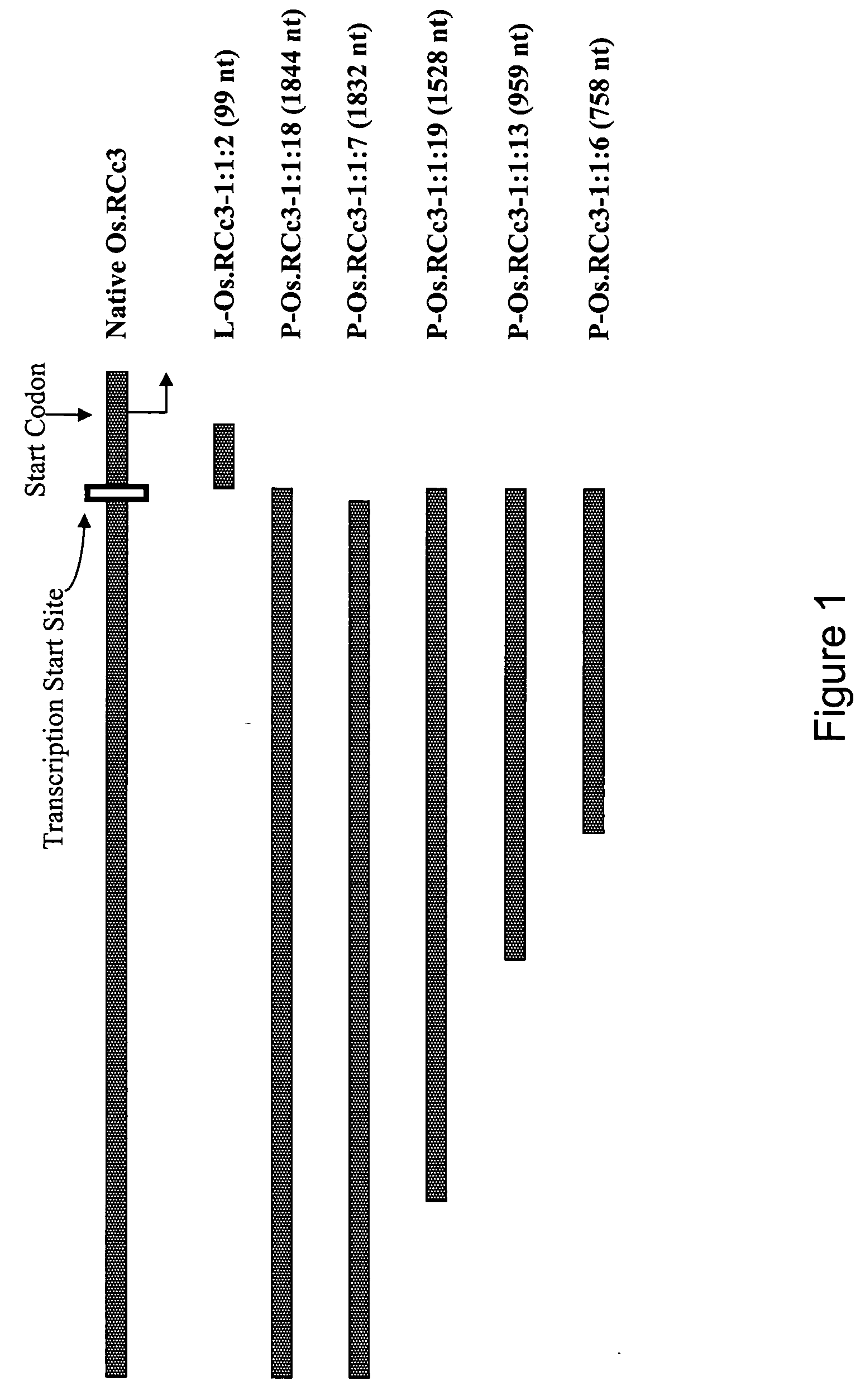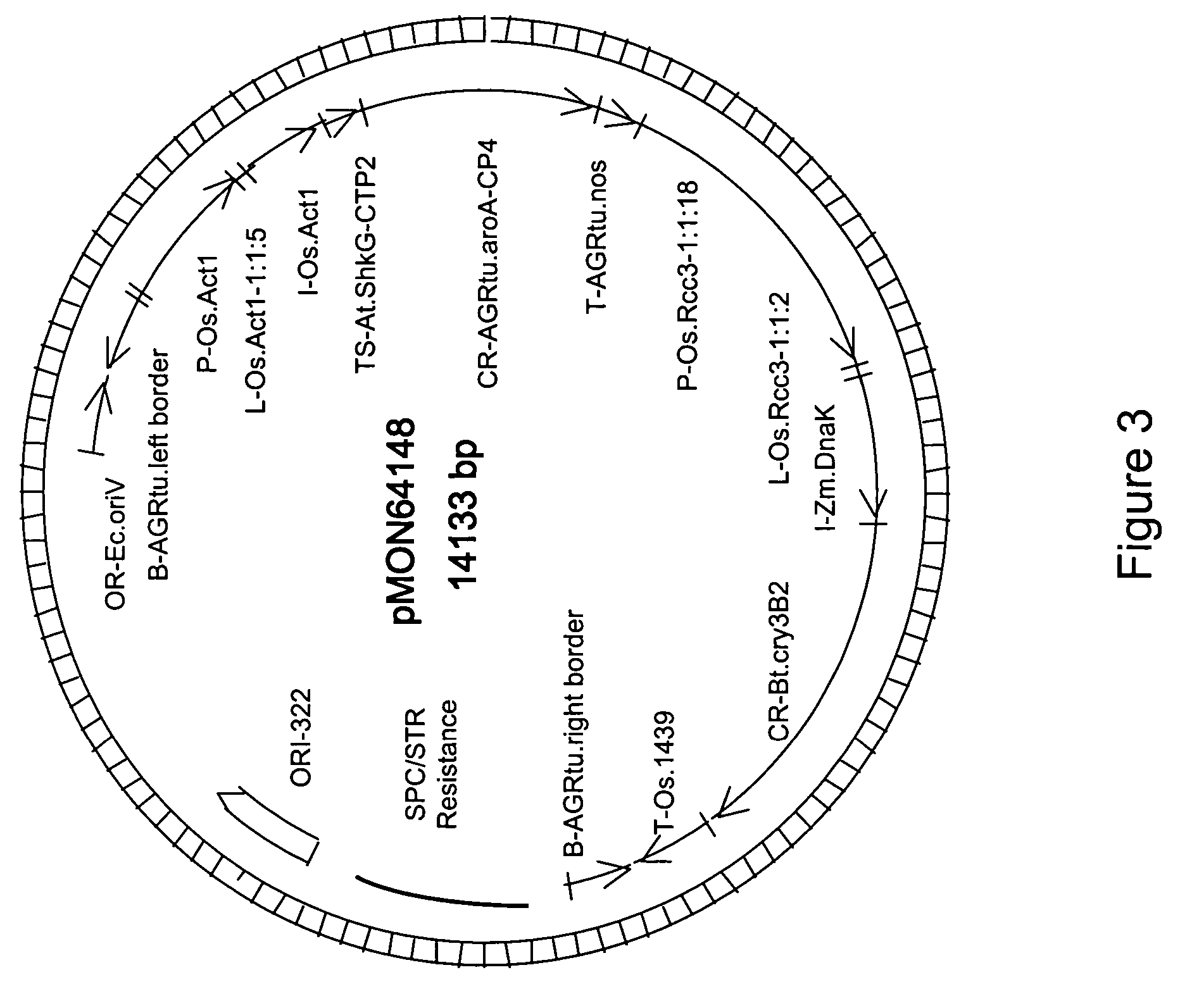RCc3 regulatory elements for use in plants
a technology of regulatory elements and plants, applied in the field of plant molecular biology and plant genetic engineering, can solve the problems that many previously identified regulatory elements fail to provide the patterns or levels of expression required to fully realize the benefits, and achieve the effect of modulating gene expression in plants
- Summary
- Abstract
- Description
- Claims
- Application Information
AI Technical Summary
Problems solved by technology
Method used
Image
Examples
example 1
Endogenous Gene Expression
[0049] Endogenous gene expression analysis was used to identify genes with root enhanced expression patterns. Electronic Northern analysis was used to compare multiple EST libraries in order to identify gene transcripts that were expressed in root, but not in seed, leaf, or pollen. Candidates were ranked by percent abundance of the transcript and by relative levels in root tissue, allowing for minimal transcript expression in seed, leaf, and pollen. The initial candidates were then validated by TaqMan® quantitative analysis (Applied Biosystems, Foster City, Calif.). Primers specific to the rice RCc3 gene (herein referred to as the Os.RCc3 gene) were used in conjunction with the SYBR Green kit (Perkin Elmer Inc., Wellesley, Mass.) using a Taqman machine (Applied Biosystems, Foster City, Calif.) and standard protocols supplied by the manufacturer to amplify transcript specific sequences out of leaf, root, floral meristem, or seed cDNA. This analysis confirme...
example 2
Identification and Cloning of Regulatory Elements
[0050] The 5′ non coding region of Os.RCc3 was identified using bioinformatic methods from a dataset of rice genomic DNA sequence using the Os.RCc3 cDNA sequence. The Os.RCc3 leader (referred to herein as L-Os.RCc3) and five variants of the Os.RCc3 promoter (referred to herein as P-Os.RCc3) were then constructed as described below. See FIG. 1 and Table 2. The first promoter variants were two long variants, P-Os.RCc3-1:1:18 (SEQ ID NO: 1) and as P-Os.RCc3-1:1:7 (SEQ ID NO: 2) which are 1844 and 1832 nucleotides long, respectively. These were cloned from rice genomic DNA by designing three primers (OsRCc3NotF, OcRCc3Bg1R1, and OcRCc3Bg1R2) based on the genomic sequence data. These primers included restriction enzyme sites for use in subsequent subclonings; forward primer OsRCc3NotF (SEQ ID NO: 7) contained a NotI restriction site and reverse primers OcRCc3Bg1R1 (SEQ ID NO: 8) and OcRCc3Bg1R2 (SEQ ID NO: 9) contained a Bgl II restrictio...
example 3
Promoter Analysis in Stable Transgenic Corn Plants with GUS
[0055] Corn plants were transformed with pMON84001, containing P-Os.RCc3-1:1:6 and L-Os.RCc3-1:1:2 operably linked to the GUS transgene, for histochemical GUS analysis in plants. Plants were transformed using methods known to those skilled in the art. Particle bombardment of corn H99 immature zygotic embryos may be used to produce transgenic maize plants. Ears of maize H99 plants are collected 10-13 days after pollination from greenhouse grown plants and sterilized. Immature zygotic embryos of 1.2-1.5 mm are excised from the ear and incubated at 28° C. in the dark for 3-5 days before use as target tissue for bombardment. DNA comprising an isolated DNA construct containing the selectable marker for kanamycin resistance (NPTII gene) and the screenable marker for β-D-Glucuronidase (GUS gene) is gel purified and used to coat 0.6 micron gold particles (Bio-Rad, Hercules, Calif.) for bombardment. Macro-carriers are loaded with th...
PUM
| Property | Measurement | Unit |
|---|---|---|
| volume | aaaaa | aaaaa |
| weight | aaaaa | aaaaa |
| weight | aaaaa | aaaaa |
Abstract
Description
Claims
Application Information
 Login to View More
Login to View More - R&D
- Intellectual Property
- Life Sciences
- Materials
- Tech Scout
- Unparalleled Data Quality
- Higher Quality Content
- 60% Fewer Hallucinations
Browse by: Latest US Patents, China's latest patents, Technical Efficacy Thesaurus, Application Domain, Technology Topic, Popular Technical Reports.
© 2025 PatSnap. All rights reserved.Legal|Privacy policy|Modern Slavery Act Transparency Statement|Sitemap|About US| Contact US: help@patsnap.com



